Arkansas is currently known as the “Natural State” and can be found in the southern-central region of the US. The state is known for its vast forestland. About 56% of Arkansas is covered in forests – roughly 19 million acres.

The geography of the state is varied today. However, in the Paleozoic era, Arkansas was covered by seawater. Only during the Permian period, the state’s territory was dry land. At the same time, completely different species of animals used to live here. One notable mention is Arkansaurus, which bears the state’s name.
If you want to learn more about the animals that lived in Arkansas but are now extinct, keep on reading because we’ll give you some interesting facts!
1. Sauropods
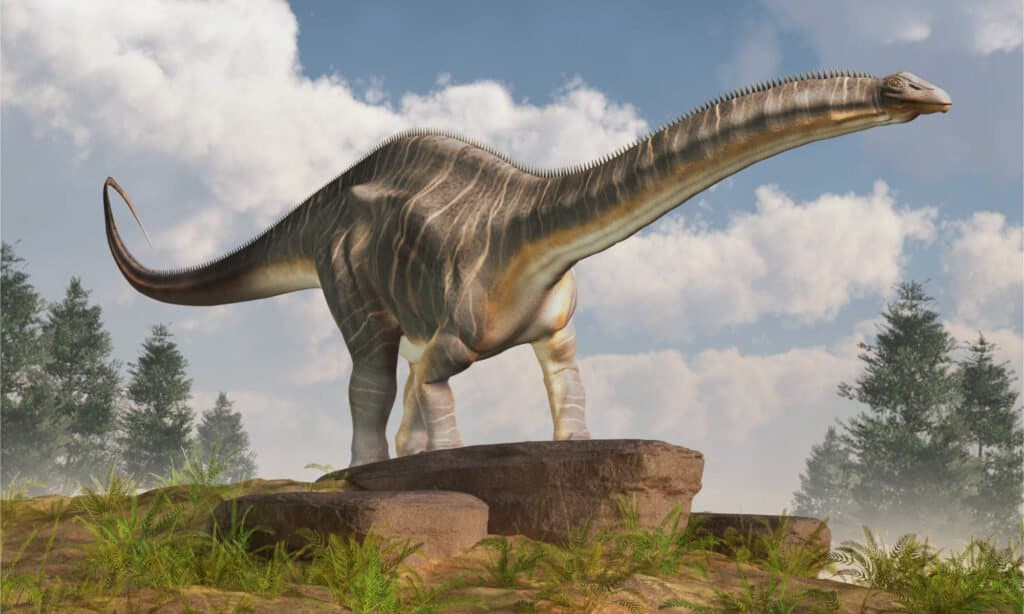
Sauropods were large dinosaurs with long necks and tails and thick legs.
©Daniel Eskridge/Shutterstock.com
| Sauropods | |
|---|---|
| Kingdom | Animalia |
| Phylum | Chordata |
| Clade | Dinosauria |
| Clade | Saurischia |
| Clade | Sauropodomorpha |
| Clade | Anchisauria |
| Clade | Sauropoda |
| Extinct since | 66 million years ago |
The southwestern part of Arkansas is home to many sauropod footprints. The Sauropods were large dinosaurs with long necks and tails and thick legs. Their name translates to lizard-footed.
Some sauropod species were the largest animals to ever live on land. The most well-known species in this clade is the Brontosaurus.
Sauropods lived between the Late Triassic and Late Cretaceous periods. The clade went extinct about 66 million years ago. These dinosaurs were huge. The smallest specimens, dwarf sauropods, were about 20 feet (5–6 m) long. The longest discovered sauropod was Supersaurus, a massive 108–112 ft (33–34 m) long dinosaur.
2. Arkansaurus

Arkansaurus lived during the Early Cretaceous period.
©Nobu Tamura Email:[email protected] http://spinops.blogspot.com/ http://paleoexhibit.blogspot.com/ CC BY-SA 4.0 – License
| Arkansaurus | |
|---|---|
| Kingdom | Animalia |
| Phylum | Chordata |
| Clade | Dinosauria |
| Clade | Saurischia |
| Clade | Theropoda |
| Clade | Ornithomimosauria |
| Genus | Arkansaurus |
| Species | Arkansaurus fridayi |
| Extinct since | 121.4-113.0 million years ago |
Arkansaurus means Arkansas lizard and lived during the Early Cretaceous period. It went extinct around 121.4-113.0 million years ago. The dinosaur is believed to have been a fast-moving omnivore related to Ornithomimus. Analyzing its fossil, discovered in Arkansas, it was shown that Arkansaurus was about 6–15 feet (1.8–4.6 m tall) and had long arms.
The dinosaur’s fossils were discovered by Joe B. Friday in a ditch created during the reconstruction of Arkansas Highway 24. Dr. James H. Quinn, a paleontologist, was the first person to look at the fossils and figure out that they were indeed from dinosaurs.
Arkansaurus resembled a modern ostrich but featured a much fluffier tail and strongly curved foot claws.
3. Megatherium
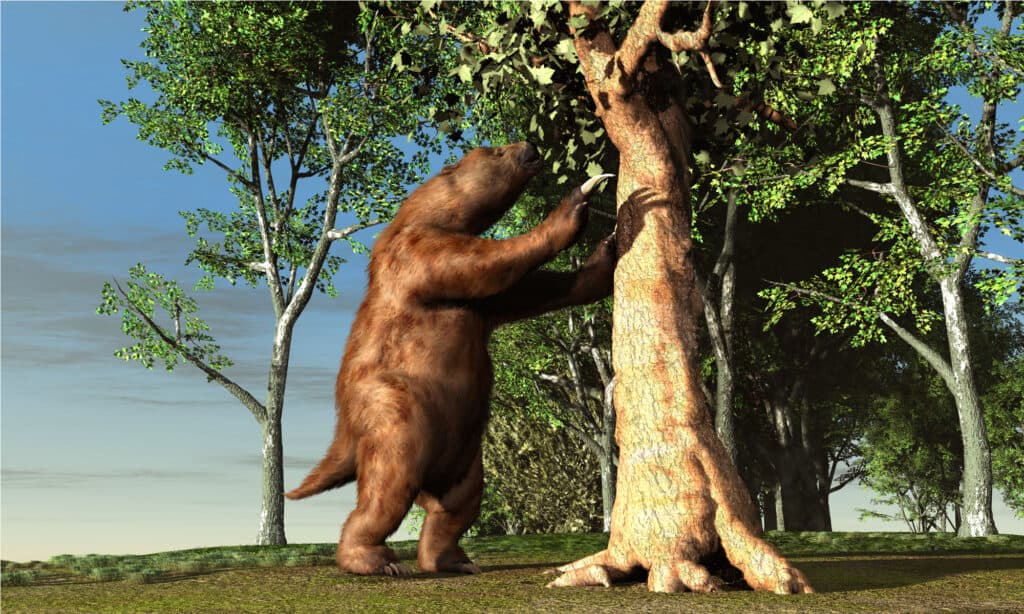
Megatherium inhabited Arkansas during the Ice Age.
©Esteban De Armas/Shutterstock.com
| Megatherium | |
|---|---|
| Kingdom | Animalia |
| Phylum | Chordata |
| Class | Mammalia |
| Order | Pilosa |
| Clade | Megatheria |
| Family | Megatheriidae |
| Subfamily | Megatheriinae |
| Genus | Megatherium |
| Extinct since | 12,000 years ago |
Megatherium is known as the giant ground sloth that lived during the Early Holocene period and went extinct about 12,000 years ago. The most common species of Megatherium is M. americanum. Its distinctive feature is its size—it is close to an elephant.
This species inhabited Arkansas during the Ice Age, alongside mammoths and mastodons. It was as big as modern African elephants and is still one of the largest land mammals to have existed in the world. A specimen could weigh as much as 8,800 lbs (4 t) and grow as tall as 20 feet (6 m).
Megatherium specimens were capable of both quadruped and bipedal locomotion, making them a rather scary sight.
4. Mammoths
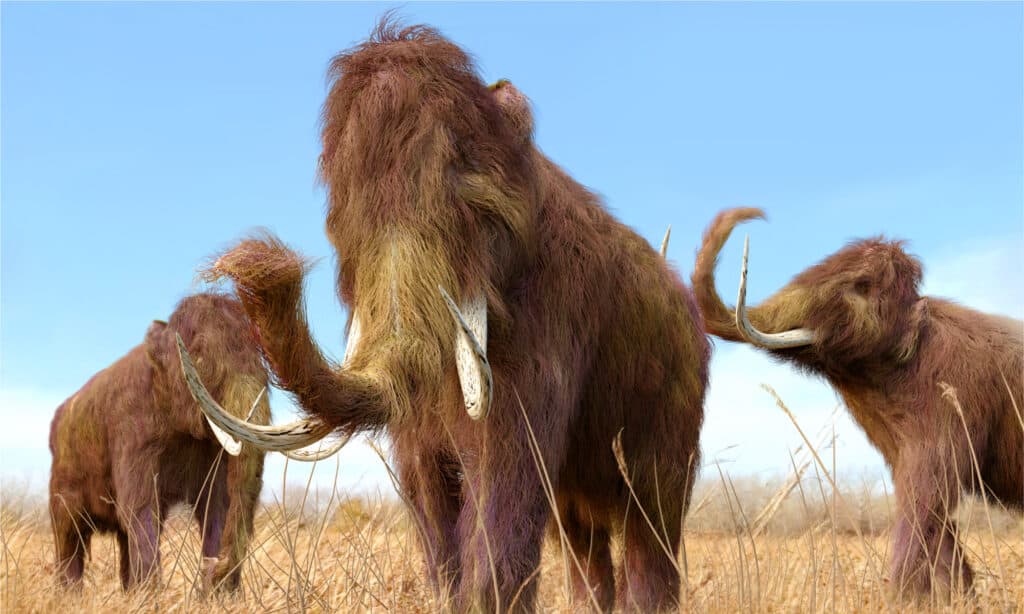
Mammoths lived in Arkansas alongside giant ground sloths during the Pliocene and Holocene periods.
©Aunt Spray/Shutterstock.com
| Mammoths | |
|---|---|
| Kingdom | Animalia |
| Phylum | Chordata |
| Class | Mammalia |
| Order | Proboscidea |
| Family | Elephantidae |
| Subfamily | Elephantinae |
| Tribe | Elephantini |
| Genus | Mammuthus |
| Extinct since | 4,000 years ago |
Mammoths lived in Arkansas alongside giant ground sloths during the Pliocene and Holocene periods. They went extinct around 4,000 years ago, although some suggest that isolated populations of mammoths might still inhabit the tundra of the Northern Hemisphere.
The main characteristics of mammoths were their long and curved tusks. Mammoth species that inhabited northern lands featured a long hair covering to resist low temperatures better. Most mammoths weighed around 17,637 lb (8 t) and reached a height of 13.1 feet (4 m). The animal could survive temperatures as low as -58 °F (-50 °C). No wonder they inhabited Arkansas during the Ice Age!
The mammoths are believed to have gone extinct due to severe warming episodes, overhunting, or both.
5. Mastodons
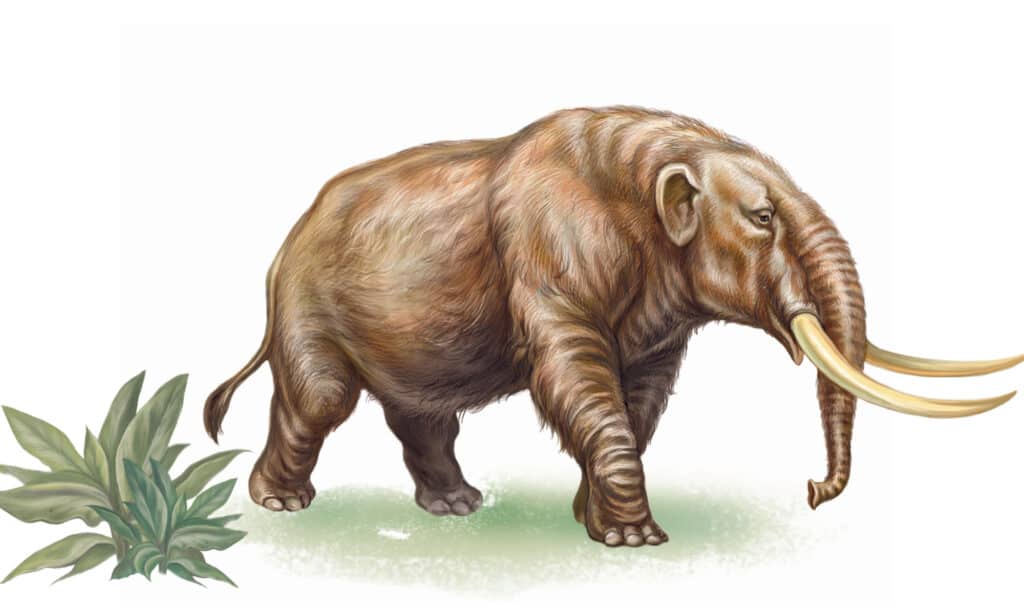
Mastodons inhabited North and Central America and went extinct at the end of the Pleistocene period.
©Liliya Butenko/Shutterstock.com
| Mastodons | |
|---|---|
| Kingdom | Mastodons |
| Phylum | Chordata |
| Class | Mammalia |
| Order | Proboscidea |
| Family | Mammutidae |
| Genus | Mammut |
| Extinct since | 10-11,000 years ago |
A mastodon was not a mammoth! While mammoths are part of the Elephantidae family, mastodons are part of the Mammutidae family. It is a bit ambiguous, but the differences are clear, as you’ll see below.
Mastodons inhabited North and Central America and went extinct at the end of the Pleistocene period, about 10-11,000 years ago. There are five discovered species of mastodon: M. americanum, M. matthewi, M. pacificus, M. raki, and M. cosoensis.
In terms of size, the average mastodon would grow to a height of 7 ft 7 in (2.3 m) and weigh around 17,196 lb (7.8 t). The animal was characterized by strongly upward-curved tusks. An interesting fact is how mastodons are depicted in modern media – with a coat of hair most of the time. However, no discovered evidence suggests that mastodons featured hair, fur, or anything similar.
6. Passenger pigeon
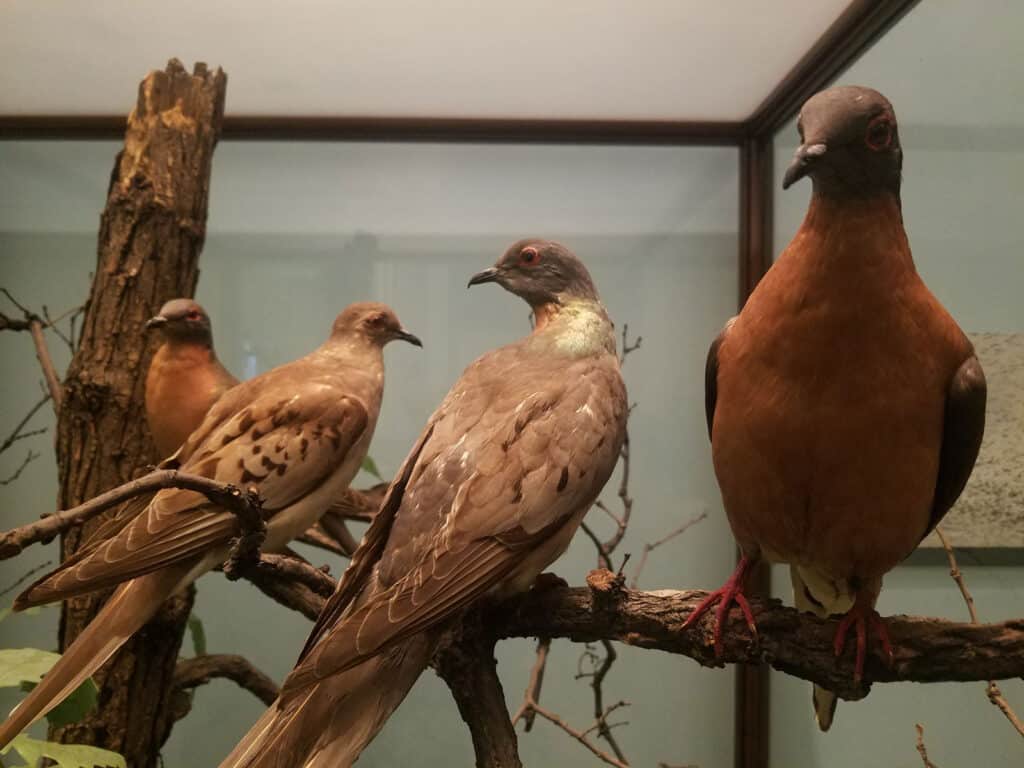
The main characteristic of the passenger pigeon is its
sexual dimorphism.
©ChicagoPhotographer/Shutterstock.com
| Passenger pigeon | |
|---|---|
| Kingdom | Animalia |
| Phylum | Chordata |
| Class | Aves |
| Order | Columbiformes |
| Family | Columbidae |
| Genus | Ectopistes |
| Species | Ectopistes migratorius |
| Extinct since | 1914 |
The passenger pigeon was a species endemic to North America, known to have inhabited Arkansas as well. It went extinct in 1914. The word “passenger” is derived from the French for “passing by,” while its scientific name is Ectopistes migratorius. Both its names and scientific names showcase the bird’s migratory nature.
The species went extinct due to anthropogenic extinction. As the name implies, extinction is caused by humans; the worst part is that it’s ongoing.
The main characteristic of the species is its sexual dimorphism. Namely, the male and female specimens showcased entirely different features. For instance, male specimens had gray upper parts, light underparts, black spots on the wings, and iridescent bronze feathers on their necks. On the other hand, female specimens were browner and duller than male ones.
The photo featured at the top of this post is © Esteban De Armas/Shutterstock.com
Thank you for reading! Have some feedback for us? Contact the AZ Animals editorial team.






